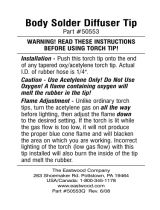
4 www.harrisproductsgroup.com
FORWARD
Brazing is a metal joining process utilizing a filler metal which melts
above 840º F and below the melting point of the base metals. The filler
metal is drawn into the joint by capillary attraction producing a sound,
leak-proof connection.
These sentences briefly describe a process which is an integral part of
manufacturing, installing, and repairing refrigeration and air
conditioning systems. This handbook is designed to assist the
serviceman or contractor in making sound brazed joints and selecting
the correct filler metal for each application.
WARNING: Protect yourself and others. Read and understand this
information. Brazing and soldering alloys and fluxes may
produce FUMES AND GASES hazardous to your health.
• Before use, read and understand the manufacturer’s instructions, Material
Safety Data Sheets (MSDS) and your employer’s safety practices.
• Keep your head out of the fumes.
• Use enough ventilation or exhaust at the flame to keep fumes and
gases from your breathing zone and the general area.
• For maximum safety, be certified for and wear a respirator at all times
when welding or brazing.
• Wear correct eye, ear, and body protection.
• Do not touch live electrical parts.
• See American National Standard Z49.1, Safety in Welding, Cutting and
Allied Processes, published by the American Welding Society, 550 N.W.
LeJeune Rd., Miami Florida 33126; OSHA Safety and Health Standards,
29 CFR 1910, Available from the U.S. Government Printing Office,
Superintendent of Documents, P.O. Box 371954, Pittsburgh,
PA15250-7954.
• Material Safety Data Sheets are available for all Harris products. Each
MSDS contains detailed safety and health information about possible
hazards associated with use of a particular product. MSDS are available
from your employer or by contacting The Harris Products Group 4501
Quality Place, Mason, OH 45040-1971.
STATEMENT OF LIABILITY
This information and recommendations contained in this publication
have been compiled from sources believed to be reliable and to rep-
resent the best information on the subject at the time of issue. No
warranty, guarantee, or representation is made by The Harris
Products Group as to the absolute correctness or sufficiency of any
representation contained in this and other publications; The Harris
Products Group assumes no responsibility in connection herewith;
nor can it be assumed that all acceptable safety measures are con-
tained in this (and other) publications, or that other or additional
measures may not be required under particular or exceptional
conditions or circumstances.





















